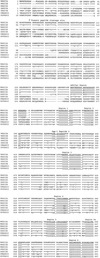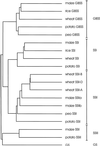The localization and expression of the class II starch synthases of wheat
- PMID: 10444098
- PMCID: PMC59348
- DOI: 10.1104/pp.120.4.1147
The localization and expression of the class II starch synthases of wheat
Abstract
The starch granules of hexaploid wheat (Triticum aestivum) contain a group of three proteins known as SGP-1 (starch granule protein-1) proteins, which have apparent molecular masses of 100, 108, and 115 kD. The nature and role of these proteins has not been defined previously. We demonstrate that these polypeptides are starch synthases that are present in both the starch granule and the soluble fraction at the early stages of wheat endosperm development, but that are exclusively granule bound at mid and late endosperm development. A partial cDNA clone encoding a fragment of the 100-kD protein was obtained by screening a wheat endosperm cDNA expression library using monoclonal antibodies. Three classes of cDNA were subsequently isolated from a wheat endosperm cDNA library by nucleic acid hybridization and were shown to encode the 100-, 108-, and 115-kD proteins. The cDNA sequences are highly homologous to class II starch synthases and have the highest homology with the maize SSIIa (starch synthase IIa) gene. mRNA for the SGP-1 proteins was detected in the leaf, pre-anthesis florets, and endosperm of wheat and is highly expressed in the leaf and in the grain during the early to mid stages of development. We discuss the roles of the SGP-1 proteins in starch biosynthesis in wheat.
Figures







References
-
- Ainsworth C, Clark J, Balsdon J. Expression, organisation and structure of the genes encoding the waxy protein (granule-bound starch synthase) in wheat. Plant Mol Biol. 1993;22:67–82. - PubMed
-
- Ball S, Guan H-P, James M, Myers A, Keeling P, Mouille G, Buléon A, Colonna P, Preiss J (1996) From glycogen to amylopectin: a model for the biogenesis of the plant starch granule. Cell 349–352 - PubMed
-
- Boyer CD, Preiss J. Multiple forms of starch branching enzyme of maize: evidence for independent genetic control. Biochem Biophys Res Comm. 1978;80:169–175. - PubMed
Publication types
MeSH terms
Substances
Associated data
- Actions
LinkOut - more resources
Full Text Sources
Other Literature Sources
Research Materials

